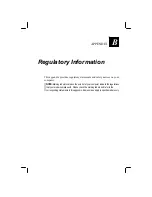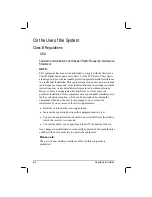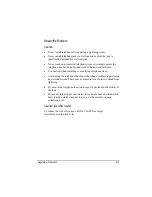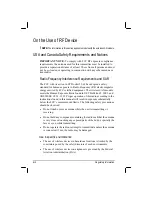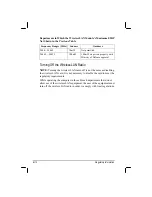
Hard Disk Encryption
C-3
A:
DES (Data Encryption Standard) was originally introduced by NSA (National
Security Agency) and IBM and has since become a Federal data encryption
standard as defined in FIPS 46-3 (Federal Information Processing Standard).
DES works on 64-bit data segments with a 64-bit key of which 8 bits provide
parity, resulting in a 56-bit effective length. A variant on DES is TDES, in which
the plain text is processed three times with two or three different DES secret
keys. With two encryption keys used, the result is an encryption equivalent to
using a 112-bit (128-bit) key. With three keys, the result is an encryption
equivalent to using a 168-bit (192-bit) key. In practice with a 128-bit TDES, the
plain text is encrypted with the first key, decrypted with the second key, and
then encrypted again with the first key.
Q:
How is key length related to security?
A:
In general, a larger key length creates a stronger cipher, which means an
eavesdropper must spend more time and resources to find the decryption key.
For instance, 2
40
(a DES 40-bit strength) represent a key space of
1,099,511,627,776 possible combinations. While this number seems
impressive, it is definitely feasible for a microprocessor or a specially designed
ASIC to perform the huge number of calculations necessary to derive the key.
Thus a 40-bit length cipher offers a bare minimum protection for your
confidentiality and privacy. Fortunately the “work factor” increases exponentially
as we increase the key length.
Q:
Such that X-Wall LX-40 (DES 40-bit strength) is insecret?
A:
Not true. Above explained
Secret Key
finding process is specifically relating to
decrypting software-based encryption. The innovative
X-Wall
hardware based
encryption solution increases the difficulties tremendously as every guess of the
S
ecret Key
requires a hardware reset (power on). To break an
X-Wall LX-40
encrypted hard drive, one must process at least 500 billion times (50% of the
available key space) reboot. As such,
X-Wall
even with its DES 40-bit strength
will be strong enough against massive computer attacks.
Q:
How would I make sure the security offered by X-Wall LX is solid?
A:
The DES/TDES hardware engine that
X-Wall LX
utilized has been certified by the
NIST (National Institute of Standards and Technology) and CSE (The Canadian
Security Establishment)
, for which the certificates can be reviewed on NIST web
links: http://csrc.nist.gov/cryptval/des/desval.html &
http://csrc.nist.gov/cryptval/des/tripledesval.html. These hardware algorithms are
certified to provide reliable security; at full strength it is nearly impossible to access the
encrypted data by guessing or deriving the right DES/TDES Key. Because everything
on the disk is encrypted, your data is safe even if attackers try to boot from their own
disk, or to move your disk to an unprotected machine.
Q:
Why do I need to use the Secret Key?
A:
The
X-Wall Secret Key covers 5 characters as we set on HDD encryption. It
contains the
DES/TDES
“Secret Key”
that is used by
X-Wall LX
to encrypt or
decrypt data. Without the key, the protected disk drive cannot be booted and
there is no access into the PC. Together the
X-Wall Secret Key
and
X-Wall LX
comprise an effective user authentication for access control and encryption for
data protection. The
X-Wall Secret Key
serves as user authentication for
access control while
X-Wall LX
encrypts and decrypts.
Q:
What happens if my Secret Key is lost or stolen?
Summary of Contents for M220
Page 1: ...M220 Operation Manual Part Number 799001151001R00 24 Mar 062006 ...
Page 7: ...v European Union CE Marking and Compliance Notices B 9 ...
Page 8: ......
Page 11: ...M220 Operation Manual Part Number 799001151001R00 24 Mar 062006 ...
Page 17: ...v European Union CE Marking and Compliance Notices B 9 ...
Page 18: ......
Page 38: ...1 18 Getting Started ...
Page 65: ...Operating Your Computer 2 27 3 Click on Next to continue ...
Page 69: ...Operating Your Computer 2 31 ...
Page 88: ...Expanding Your Computer 4 9 Connect to IR device ...
Page 93: ...4 14 Expanding Your Computer ...
Page 98: ...Setup Configuration Utility SCU 5 5 Main Menu Date and Time ...
Page 100: ...Setup Configuration Utility SCU 5 7 Advanced Menu Geyserville Support ...
Page 104: ...Setup Configuration Utility SCU 5 11 Security Menu Power on Password ...
Page 107: ...5 14 Setup Configuration Utility SCU Boot Menu Boot Sequence ...
Page 110: ...Setup Configuration Utility SCU 5 17 ...
Page 116: ...6 6 Installing Software Drivers ...

